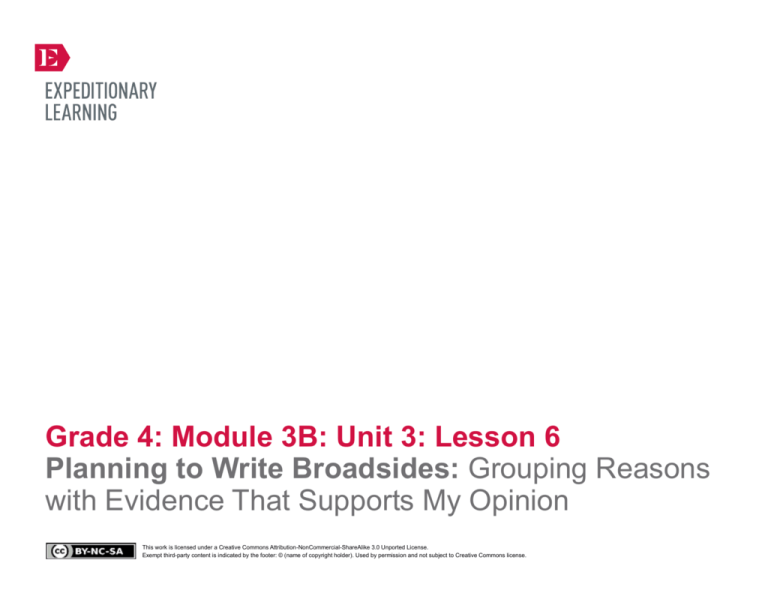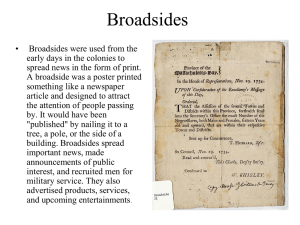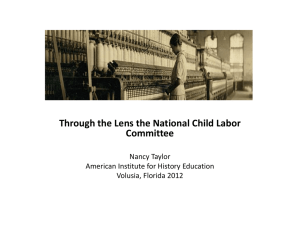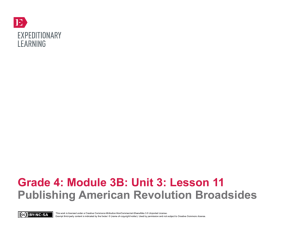
Grade 4: Module 3B: Unit 3: Lesson 6
Planning to Write Broadsides: Grouping Reasons
with Evidence That Supports My Opinion
This work is licensed under a Creative Commons Attribution-NonCommercial-ShareAlike 3.0 Unported License.
Exempt third-party content is indicated by the footer: © (name of copyright holder). Used by permission and not subject to Creative Commons license.
GRADE 4: MODULE 3B: UNIT 3: LESSON 6
Planning to Write Broadsides:
Grouping Reasons with Evidence That Supports My Opinion
Long-Term Targets Addressed (Based on NYSP12 ELA CCLS)
I can write an opinion piece that supports a point of view with reasons and information. (W.4.1)
I can recall information that is important to a topic. (W.4.8)
I can sort my notes into categories. (W.4.8)
Supporting Learning Targets
Ongoing Assessment
• I can use historically accurate reasons and evidence to support my opinion about the American
Revolution.
• American Revolution Broadside graphic organizer
• I can group together reasons with related evidence in my broadside.
Copyright © 2013 by Expeditionary Learning, New York, NY. All Rights Reserved.
NYS Common Core ELA Curriculum • G4:M3B:U3:L6 • June 2014 •
1
GRADE 4: MODULE 3B: UNIT 3: LESSON 6
Planning to Write Broadsides:
Grouping Reasons with Evidence That Supports My Opinion
Agenda
Teaching Notes
1. Opening
• This portion of the unit begins the writing process for the performance task located in Lesson 13. Be
sure students have a system for organizing their writing resources (research folder from Unit 1 and Unit
1 texts), graphic organizers, and drafts.
A. Engaging the Writer: Anticipating the Learning
Targets on the Rubric/Reviewing Learning Targets
(10 minutes)
2. Work Time
• In this lesson students refer to many anchor charts during the Opening and Work Time. In advance,
read through the lesson to visualize how various charts are used, and organize accordingly.
A. Planning a Broadside: Guided Practice with the
Quaker Broadside (20 minutes)
• Prepare a larger version of American Revolution Broadside rubric on chart paper. You will add criteria
for success toward the performance task on this chart.
B. Planning a Broadside: Independent Practice (20
minutes)
• Co-constructing the rubric based on the learning targets outlined from the standards allows students to
clearly picture what meeting these targets will look like as they write their broadsides. Research shows
that engaging students in the assessment process engages, supports, and holds students accountable for
their learning. This practice helps all learners, but it supports struggling learners the most.
3. Closing and Assessment
A. American Revolution Broadside Rubric: Adding
Criteria for Success (10 minutes)
4. Homework
A. Continue reading in your independent reading book
for this unit at home.
Copyright © 2013 by Expeditionary Learning, New York, NY. All Rights Reserved.
• Students continue to work with their writing partner in this lesson and the lessons that follow.
• In advance:
– Review: Mix and Mingle in Checking for Understanding techniques (see Appendix).
– Post: Learning targets, Exploring Opinions as Readers and Writers anchor chart, and Characteristics
of Broadsides anchor chart.
NYS Common Core ELA Curriculum • G4:M3B:U3:L6 • June 2014 •
2
GRADE 4: MODULE 3B: UNIT 3: LESSON 6
Planning to Write Broadsides:
Grouping Reasons with Evidence That Supports My Opinion
Lesson Vocabulary
Materials
historically accurate, reasons, evidence
• Document camera
• American Revolution Broadside rubric (from Lesson 5; one per student and one enlarged to display as an anchor chart)
• Exploring Opinions as Readers and Writers anchor chart (from Lesson 1)
• Characteristics of Broadsides anchor chart (from Lesson 3)
• American Revolution Broadside rubric chart (new; co-created during Opening A)
• American Revolution Broadside graphic organizer: Quaker model (completed, for teacher reference)
• Sticky notes (one per student)
• Quaker Broadside: final copy (from Lesson 5)
• Research folders (from Unit 1, Lesson 1)
• Reasons/Evidence graphic organizer: Quaker broadside (from Lesson 5; one for display)
• Notes and texts from Unit 1 (students’ copies)
– “Revolutionary War” and What Happened and Why graphic organizer (from Unit 1, Lesson 1)
– “Incomplete Revolution” and Main Idea graphic organizer (from Unit 1, Lesson 7)
– “Thomas Jefferson and the Declaration of Independence” and Close Reading note-catcher (from Unit 1, Lesson 9)
• “Be a Patriot because …” anchor chart (from Unit 1, Lesson 3)
• American Revolution Broadside graphic organizer (one per student)
• American Revolution Broadside graphic organizer (for teacher reference)
• Writing folder (from Lesson 2)
Copyright © 2013 by Expeditionary Learning, New York, NY. All Rights Reserved.
NYS Common Core ELA Curriculum • G4:M3B:U3:L6 • June 2014 •
3
GRADE 4: MODULE 3B: UNIT 3: LESSON 6
Planning to Write Broadsides:
Grouping Reasons with Evidence That Supports My Opinion
Opening
Meeting Students’ Needs
A. Engaging the Writer: Anticipating the Learning Targets on the Rubric/Reviewing Learning Targets
(10minutes)
• Using a document camera, display the top half of the American Revolution Broadside rubric (from Lesson 5).
• Co-constructing the rubric based on
the learning targets allows students
to clearly picture what meeting
these targets will look like as they
write their broadsides.
• Review the writing prompt and learning target with the class:
* “After researching different perspectives from the American Revolution, write a broadside. Write your broadside as if you
were a Patriot, justifying your opinion on the American Revolution to someone with an opposing view. Support your
opinion with reasons and information from your research.”
• Review the learning target on the rubric:
* “I can write a broadside stating my opinion on the American Revolution.”
• When students give their thumbs up
for learning targets they, notice
which targets students anticipated
and which may need more
clarification in upcoming lessons.
• Remind students that they have become experts on the American Revolution and over the past several days have learned a
lot about how authors support their opinions with reasons and evidence. Refer to the posted Exploring Opinions as
Readers and Writers anchor chart and Characteristics of Broadsides anchor chart.
• Prompt students to mix and mingle on the following:
* “Given what we know about opinions and broadsides, what would you expect to see for learning targets on the bottom half
of this rubric?”
• Circulate and listen as the class discusses the prompt. Listen for them to say things such as: “I think one of the learning
targets will be about writing an introduction that has the opinion about the American Revolution,” or “There will be a
learning target about using evidence to support our reasons.”
• Ask students to return to their seats. Focus them on the American Revolution Broadside rubric chart. Tell students
that you would like them to give you a thumbs-up if the target is something they expected as you read each aloud.
• Read the targets in the criteria for success table on the rubric one at a time.
Copyright © 2013 by Expeditionary Learning, New York, NY. All Rights Reserved.
NYS Common Core ELA Curriculum • G4:M3B:U3:L6 • June 2014 •
4
GRADE 4: MODULE 3B: UNIT 3: LESSON 6
Planning to Write Broadsides:
Grouping Reasons with Evidence That Supports My Opinion
Meeting Students’ Needs
Opening (continued)
• Tell students that today they will focus on two of these targets. Point out the following learning targets under the Ideas and
Organization sections on the chart:
* “I can use historically accurate reasons and evidence to support my opinion about the American Revolution.”
* “I can group together reasons with related evidence in my broadside.”
• Discuss the phrase historically accurate. Ask students to share with a partner what they think this phrase means. Cold call
pairs to share. Listen for explanations like: “It means the information in our broadsides needs to be correct for the time
period of the American Revolution,” or “Our reasons and evidence must be based on our research.” Clarify this target as
necessary.
• For the second target, ask students:
* “What do you think it means to ‘group reasons with related evidence’?”
• Have students turn and talk once again. Listen for explanations like: “It means our evidence has to match our reasons.”
• Tell students that today’s lesson will help them clarify these targets further so they can add criteria for success to the rubric.
Copyright © 2013 by Expeditionary Learning, New York, NY. All Rights Reserved.
NYS Common Core ELA Curriculum • G4:M3B:U3:L6 • June 2014 •
5
GRADE 4: MODULE 3B: UNIT 3: LESSON 6
Planning to Write Broadsides:
Grouping Reasons with Evidence That Supports My Opinion
Work Time
Meeting Students’ Needs
A. Planning a Broadside: Guided Practice with the Quaker Broadside (20 minutes)
• Tell students that you would like their help analyzing the Quaker broadside. Use the characteristics outlined on the
Characteristics of Broadsides anchor chart to guide your analysis (see the American Revolution Broadside graphic
organizer: Quaker model in the supporting materials as an example).
• During the guided practice, be sure
to note which students are
struggling. This can help you
determine with whom to confer
during the independent practice
(Work Time B).
• Before beginning your modeling, do the following:
– Distribute one sticky note to each student.
– Invite students to get out their copy of the Quaker broadside: final copy.
– Have students get out their research folders.
– Place students with their writing partner from Lesson 5. Students will continue to work with their writing partner for
critique and feedback throughout the unit.
• Model as follows: Tell students that you, as teacher, have already identified the opinion shared in the broadside that: “We
should stay uninvolved in the American Revolution because it goes against our beliefs.” Record this as a note in the
Introduction box. Remind students that their broadsides will be about a different topic—they will justify their opinion of the
American Revolution from the Patriot perspective.
• Explain that you also know that the Quaker broadside gives readers some background information about the American
Revolution and Quakers’ involvement.
• Ask students to work with their partner to help you identify this in the broadside by doing the following:
1. Reread the first paragraph of the Quaker broadside.
2. On a sticky note, jot down background information about the Quakers and their role in the American Revolution.
• Give students a few minutes to look over their notes, discuss, and record with their partners.
• Then ask pairs to share out their suggestions. Listen for students to suggest: “There is a lot of pressure to be involved in the
war,” or “Both sides are pressuring us to take oaths and declare our loyalty.”
Copyright © 2013 by Expeditionary Learning, New York, NY. All Rights Reserved.
NYS Common Core ELA Curriculum • G4:M3B:U3:L6 • June 2014 •
6
GRADE 4: MODULE 3B: UNIT 3: LESSON 6
Planning to Write Broadsides:
Grouping Reasons with Evidence That Supports My Opinion
Meeting Students’ Needs
Work Time (continued)
• Remind students that broadsides have headlines. Ask:
* “What is the headline for the Quaker broadside?”
• Listen for students to say: “Violence Is Not the Answer!”
• Ask:
* “What would be another strong headline for this broadside?”
• Add suggestions to the Introduction box.
• Thank students for their help. Then point to the posted American Revolution Broadside graphic organizer: Quaker model.
Explain to the class that before the Quaker model was drafted, the author determined which reasons and evidence he wanted
to include in the broadside.
• Explain to students that they have already identified the reasons the author used in their broadside on the
Reasons/Evidence graphic organizer: Quaker broadside in Lesson 5. Display that graphic organizer and invite
students to compare it to the American Revolution Broadside graphic organizer: Quaker model.
• Cold call a few students to share what they notice about the two organizers. They should notice that they have the same
information, but that the American Revolution Broadside graphic organizer: Quaker model includes planning for the
introduction and conclusion.
• Help students think about how evidence must match up with a specific reason by providing a counterexample. Point out the
sentence: “And, fighting in the army for either side will mean having to hurt or kill others.” Ask partners to discuss:
* “Could this sentence be used as evidence to support the reason that Quakers should stay uninvolved because they do not
believe in taking oaths? Why or why not?”
Copyright © 2013 by Expeditionary Learning, New York, NY. All Rights Reserved.
NYS Common Core ELA Curriculum • G4:M3B:U3:L6 • June 2014 •
7
GRADE 4: MODULE 3B: UNIT 3: LESSON 6
Planning to Write Broadsides:
Grouping Reasons with Evidence That Supports My Opinion
Meeting Students’ Needs
Work Time (continued)
• After students discuss briefly, cold call a few more pairs to share their thinking. Explain that while this sentence might be
good evidence for another reason (Quakers believe in nonviolence), it does not fit with this reason. It is important that they
group reasons with evidence that is related (or supports them); otherwise their broadsides will not make sense to the reader.
• Thank the students for their assistance. Tell them you will continue to analyze evidence related to the reasons and add notes
for what the author included in the concluding statement. Quickly review what this statement should include (a summary of
the author’s opinion), then ask students for a thumbs-up if they feel ready to plan their own broadsides or thumbs-down if
they need you to clarify how to use the graphic organizer.
• Clarify as necessary or decide which students you will confer with during the independent practice based on this
information.
B. Planning a Broadside: Independent Practice (20 minutes)
• Tell students that now they will plan their broadsides using their own graphic organizers. They will do this individually but
should sit next to their partner so they can support each other as needed. Be sure students have their texts and research
folders for gathering evidence.
• Remind students that they can refer to their Notes and texts from Unit 1 and the “Be a Patriot because …” anchor
chart as they gather evidence.
• Distribute an American Revolution Broadside graphic organizer to each student. Circulate and support as needed.
As students finish planning, have them put their materials away in their writing folder.
Copyright © 2013 by Expeditionary Learning, New York, NY. All Rights Reserved.
• Students will be using their Unit 1
research folders and Units 1 and 2
texts to select evidence. If some
students struggle in managing these
materials, consider marking the
sections of the text and their
research folders where they should
focus to gather evidence. This can
be done ahead of time or as needed
when you confer.
NYS Common Core ELA Curriculum • G4:M3B:U3:L6 • June 2014 •
8
GRADE 4: MODULE 3B: UNIT 3: LESSON 6
Planning to Write Broadsides:
Grouping Reasons with Evidence That Supports My Opinion
Closing and Assessment
Meeting Students’ Needs
A. American Revolution Broadside Rubric: Adding Criteria for Success (10 minutes)
• Gather students together and focus them on the American Revolution Broadside rubric chart again. Ask them to reread the
first learning target for the day: “I can use historically accurate reasons and evidence to support my opinion about the
American Revolution.”
• Consider adding models with
examples of “Meets” or “Does Not
Meet” to the rubric or beside it.
Using models can further clarify for
students what it means to meet the
learning target.
• Ask students to Think-Pair-Share on the following question:
* “What will it look like if we meet this target in our broadsides?”
• Listen for comments like: “We will use information from our research for our reasons and evidence,” or “We will pick
reasons that can be supported by evidence from our notes or the text.”
• Add something like the following to the “Meets” column of the rubric next to this learning target:
– All reasons are supported by evidence from our class research on the American Revolution (Units 1 and 2 texts and our
Unit 1 research folders).
• For the “Partially Meets” column, you can add the above with the word “Some” instead of “All”. For “Does Not Meet”, add
“No” instead of “All”. This will hold true for each of the learning targets for which you create criteria on the rubric in this
unit.
• Repeat a similar process with the day’s second learning target: “I can group together reasons with related evidence in my
broadside.” Add something like the following to the “Meets” column of the rubric next to this learning target:
– All reasons are supported by evidence (examples, details, and facts) that is directly related to the reasons.
• Tell students that at the start of the next lesson, they will get feedback on their plans from their writing partners based on
these criteria. Then they will write a draft of their opinion pieces.
Homework
Meeting Students’ Needs
• Continue reading in your independent reading book for this unit at home.
• An alternative to having students
finish this planning at home is to
give them additional designated
time at some point during the
school day.
Note: Add the rest of the planning notes to the Characteristics of Broadsides anchor chart (see supporting materials in this
lesson) to prepare for Lesson 7.
Copyright © 2013 by Expeditionary Learning, New York, NY. All Rights Reserved.
NYS Common Core ELA Curriculum • G4:M3B:U3:L6 • June 2014 •
9
Grade 4: Module 3B: Unit 3: Lesson 6
Supporting Materials
This work is licensed under a Creative Commons Attribution-NonCommercial-ShareAlike 3.0 Unported License.
Exempt third-party content is indicated by the footer: © (name of copyright holder). Used by permission and not subject to Creative Commons license.
GRADE 4: MODULE 3B: UNIT 3: LESSON 6
American Revolution Broadside Graphic Organizer: Quaker Model
(For Teacher Reference)
Headline
Uses words that reflect
Quaker perspective
No more than one to two
lines
Violence Is Not the Answer
Introduction
Explain your opinion
Describe the basic reason to
stay out of the war
We should stay uninvolved
in the American Revolution
because it goes against our
beliefs.
Reason Paragraph 1
Detail/Reason Paragraph: Evidence
Concluding Statement
One of our beliefs is to treat everyone equally. Each person is valued equally, so everyone
should be treated the same. We believe in simple worship, honesty, and equality. By
fighting, we are not valuing the side we fight against as equals.
Demonstrate your
beliefs and stay out of
the war!
Reason Paragraph 2
Detail/Reason Paragraph: Evidence
One of our beliefs is nonviolence. Paying taxes that go toward the military is the
same as supporting the army, which supports violence. We need to refuse to join
the Patriot army or support the war. Because we oppose violence, fighting for
either side will mean having to hurt or kill others.
Reason Paragraph 3 (optional)
Detail/Reason Paragraph: Evidence
One of our beliefs is to not take any oaths. Doing so is forbidden by the Bible because
if you always tell the truth, swearing to do so by taking an oath isn’t necessary. We
know it means you may be fined, put into prison, or condemned as Loyalists and
traitors. But, because it goes against our beliefs, you cannot do it!
Copyright © 2013 by Expeditionary Learning, New York, NY. All Rights Reserved.
NYS Common Core ELA Curriculum • G4:M3B:U3:L6 • June 2014 •
11
GRADE 4: MODULE 3B: UNIT 3: LESSON 6
American Revolution Broadside Graphic Organizer
Name:
Date:
Headline
Reason Paragraph 1
Detail/Reason Paragraph: Evidence
Concluding
Statement
Uses words that
reflect Patriot
perspective
No more than one to
two lines
Reason Paragraph 2
Detail/Reason Paragraph: Evidence
Introduction
Explain your opinion
Describe the basic
reason you have that
opinion
Reason Paragraph 3 (optional)
Detail/Reason Paragraph: Evidence
Copyright © 2013 by Expeditionary Learning, New York, NY. All Rights Reserved.
NYS Common Core ELA Curriculum • G4:M3B:U3:L6 • June 2014 •
12
GRADE 4: MODULE 3B: UNIT 3: LESSON 6
American Revolution Broadside Graphic Organizer
(Completed, For Teacher Reference)
Headline
Reason Paragraph 1
Detail/Reason Paragraph: Evidence
Uses words that reflect
Patriot perspective
The Regulars have attacked us, unprovoked. At Lexington Green, 8 men were killed and
10 wounded by the Redcoats.
Concluding Statement
No more than one to two
lines
Fight for the Cause of
Liberty!
Show your pride in the
colonies—take up arms,
boycott merchants selling
British goods, tell everyone
you know that we must fight
for our liberty!
Reason Paragraph 2
Detail/Reason Paragraph: Evidence
The British have taken away our property and personal rights. They closed our harbors
and forced us to open our homes to their soldiers. We must fight to protect ourselves. We
have to reopen the harbor and show the arrogant British that we have rights, too.
Introduction
Explain your opinion
Describe the basic reason
you have that opinion
The King doesn’t deserve
our loyalty. We have been
oppressed by the British.
Reason Paragraph 3 (optional)
Detail/Reason Paragraph: Evidence
We should be able to govern ourselves. It is unfair for American colonists to pay taxes to
the King without even being represented in Parliament.
Copyright © 2013 by Expeditionary Learning, New York, NY. All Rights Reserved.
NYS Common Core ELA Curriculum • G4:M3B:U3:L6 • June 2014 •
13








